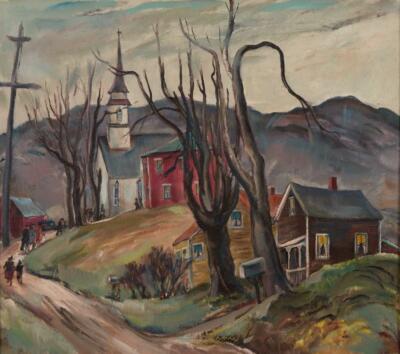Marion Huse: Picturing Pownal
April 1st – June 22nd
Marion Huse (1896-1967) was an artist whose work spanned forty years and a variety of styles and subject matter, from Regionalism in the 1930s to a more Expressionistic style that she developed in the post-war years. A native of Massachusetts, she achieved a degree of success unusual for a woman of her day, founding and operating the Springfield Art School from 1925 to 1940 and serving as supervisor of WPA art projects for western Massachusetts from 1936 to 38.
Around 1933, Huse acquired a studio in the village of Pownal, Vermont, where she spent her summers and many weekends until 1940, when she moved to Pownal full-time. This exhibition focuses on the work she created here in the southwest corner of Vermont from the mid-1930s through the 1950s, including scenes of the local landscape, with its distinctive undulating hills, and the everyday activities of her neighbors, socializing on the front porch, walking to church on a Sunday morning, or tending to their garden. These works are characteristic of Regionalist or American Scene painting that was popular throughout the country during the Depression, depicting the specificity of place, spurred by the encouragement of the WPA. During the late 1930s and through the 1940s Huse devoted time to print making and was acknowledged as one of the pioneers of the serigraph, or silkscreen, as a fine art media. A selection of her prints, depicting historic local landmarks and covered bridges, will be shown alongside her paintings.
In 1944 Huse married Dr. Robert Barstow and moved her studio to his farm on Mount Anthony Road in Pownal. Huse and her new husband lived briefly in Albany and spent 18 months in Europe after the war, but returned to their home in Pownal in 1948 and remained there until the early 1960s. During this latter part of her career Huse transitioned into a more Expressionistic style, embracing brighter, non-associative color and more vigorous abstract brushwork, inspired by her study of European modernists, applying this new approach to the local landscape.
This show will highlight a significant, but lesser-known historic woman artist, who created an important body of work in our figurative backyard during the mid-20th century.

